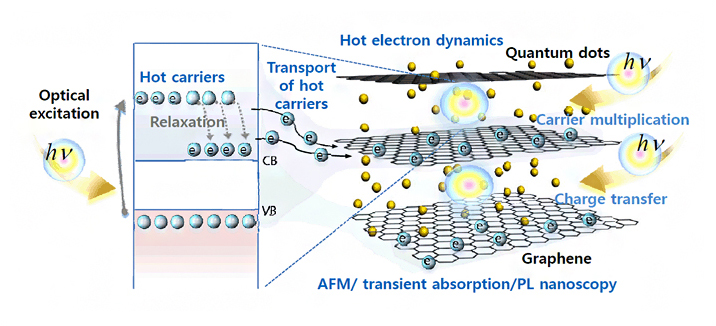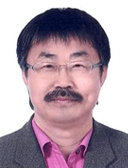mainmenu
To explore new physics phenomena of low dimensional materials
with a special emphasis on two-dimensional layered structures
Synthesis of hybrid nanostructures and their new functional properties
Nanomaterials have shown unique physical properties that have not been accessible from the bulk materials.
Depending on the atomic structures, the various physical properties such as electrical, optical, thermal, and mechanical properties change sensitively. Therefore, controlling the size and shape of nanomaterials is important. So far, various nanomaterials have been synthesized such as PbSe, PbS, CdSe, C60, CdS, carbon nanotubes, Si nanowire, Au nanowire, graphene, boron nitride and so on.
However, by themselves, these nanomaterials are not promising often even though the material properties are fascinating.
For instance, quantum dots are very efficient in carrier multiplication. But, extracting the carriers requires hybrid structures that can transport the electron to the outer circuit.
However, when these 0D and 2D nanomaterials are hybridized, the structure-related physical properties have not been studied well. In this regard, we will grow a variety of quantum dots and layered structures including MoS2, MoSe2, WS2, TiSe2, TiS2, ZrS2, ZrSe2, and build their complex hybrid systems.
We systematically study and control the electrical, optical, thermal, and interface properties. One of the target applications of hybrid structure is carrier dynamics. Optically pumped hot electrons and holes in nanostructures generate carrier multiplication phenomena during relaxation to the ground states due to confinement effect.

The relaxation mechanism, both radiative and non-radiative, is closely associated with electronic and phononic band structures of nanomaterials. Nanostructures, for example quantum dots and nanowires which are distinctly different from conventional bulk systems, are governed by different interactions of the carriers govern within strongly confined region.
The excited carriers will stay in hot and live in an extended life, rather than instantaneously annihilate into light, and will eventually induce the secondly generated hot carriers through impact ionization via electron-electron and multiple exciton interactions, resulting in carrier multiplication.
Extraction of such charges while maintaining efficient carrier multiplication is scientifically challenging and can be achieved by artificially designing hybrid nanostructures associated with work function differences at the interface.
In addition, two dimensional layered heterostructures using graphene, boron nitride, and metal oxides will be designed to realize novel quantum tunneling phenomena.
The design of such structures will be pursued in close collaboration with computational modeling group 5.
Furthermore, the dynamics of hot carriers and excitons in hybrid nanostructures are uniquely measured by using the newly developed conoscopy systems in group 4 particularly topography-absorption /emission correlation nanoscopy.
Profile

Professor
Lee, Younghee
Educational Background
Ph.D. Physics, Kent State University, USA
Professional Experiences
| 2009 ~ Present | Professor in Energy Science, Sungkyunkwan University |
|---|---|
| 2001 ~ Present | Professor in Physics, Sungkyunkwan University |
| 2007 ~ Present | Fellow, Korea Academy of Science and Technology (KAST) |
| 1987 ~ 2001 | Assistant Professor to Full Professor in Physics, Jeonbuk National University |
| 1996 ~ 1997 | Visiting Professor in Physics, Michigan State University, USA |
| 1993 ~ 1993 | Visiting Researcher, Zurich IBM Research Center, Switzerland |
| 1989 ~ 1990 | Visiting Professor in Physics, Iowa State University, Ames National Laboratory, USA |
Research Field
- Quantum dots and layered structures including graphene, BN, metal dichalcogenides and their hybrid system
- Flexible and stretchable soft electronics
- Carrier multiplication phenomena in low dimensional systems
- Photo-thermoelectrics in graphene-based thin films
Research Team
- Prof. Lim, Seongchu
- Prof. Suh, Dongseok
- Prof. Kim, Sangwoo
- Prof. Lee, Changgu
- Prof. Suh, Minah
- Prof. Ahn, Joungreal
- Prof. Yu, Woojong
- Prof. Heo, Chaejeong
- Dr. So, Kangpyo
- Dr. Duong, Dinh Loc









